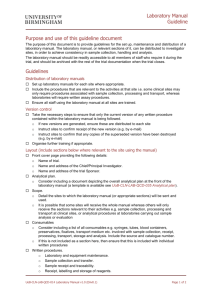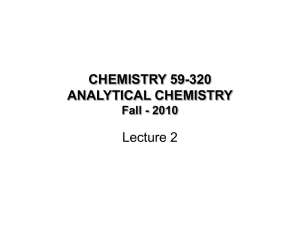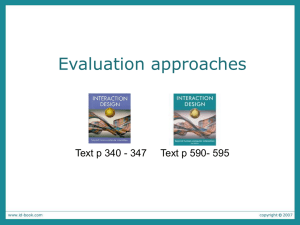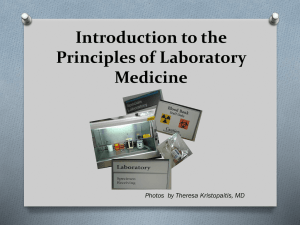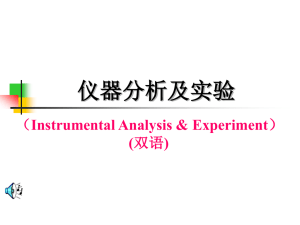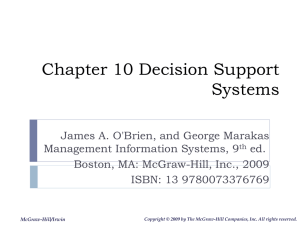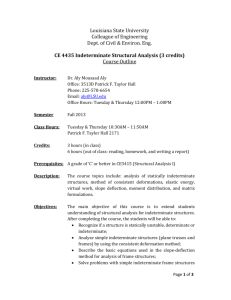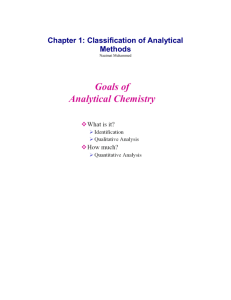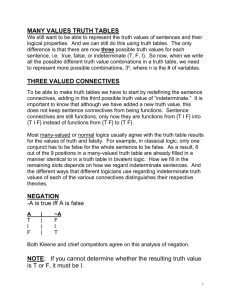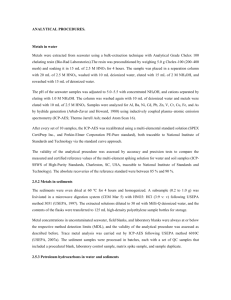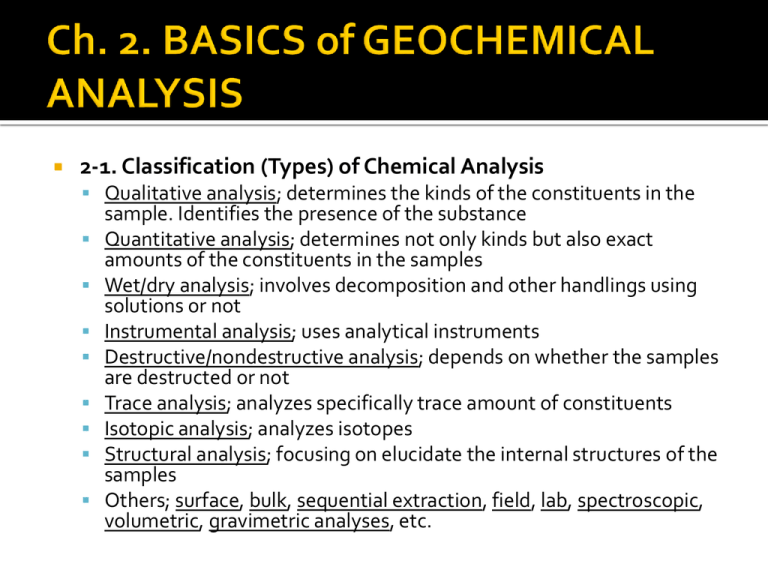
2-1. Classification (Types) of Chemical Analysis
Qualitative analysis; determines the kinds of the constituents in the
sample. Identifies the presence of the substance
Quantitative analysis; determines not only kinds but also exact
amounts of the constituents in the samples
Wet/dry analysis; involves decomposition and other handlings using
solutions or not
Instrumental analysis; uses analytical instruments
Destructive/nondestructive analysis; depends on whether the samples
are destructed or not
Trace analysis; analyzes specifically trace amount of constituents
Isotopic analysis; analyzes isotopes
Structural analysis; focusing on elucidate the internal structures of the
samples
Others; surface, bulk, sequential extraction, field, lab, spectroscopic,
volumetric, gravimetric analyses, etc.
2-2. Glossaries (Definition of Terms)
2-2-1. Solutions & concentrations
▪
▪
▪
▪
▪
▪
▪
Solvent; dissolves
Solute; being dissolved
Solution; homogenized body of solvent + solute
Molarity (M); conc. unit, mole # of solute in 1L solution
Molality (m); conc. Unit, mole # of solute in 1kg solvent
Normality (N); ditto, # of equivalents of silute in 1L solution
Formality (F); ditto, # of moles of the combined sub. In 1L
solution
▪ %; ditto, part per hundred
▪ %o; part per thousand
▪ Ppm, ppb, ppt; part per million, billion, trillion
2-2-2. Terms frequently used in Chem. Anal.
▪ Signal; analytical respond proportional to the amount of analytical
objects (constituents)
▪ Backgrounds; a group of signals uncapable of providing analytical
information
▪ Detection limit; the smallest signal distinguished from the backgrounds
with enough confidence
▪ Sensitivity; the extent of signal respond upon a given amount of
analytical object. Closely related to the DL
▪ Precision; reproducibility of results (signals)
▪ Accuracy; nearness of the measurements to the accepted (true) value
▪ Standard; samples used for the calibration of the signals (for the same
analytical method)
▪ Reference material; used for checking the accuracy of the method
▪ Aliquot; a part of the sample used for analysis
▪ Significant figures; those figures (digits) meaningful (with certainty)
Fig. 2-1. The red spectrum shows excitation with alpha particles (PIXE) and x rays (XRF).
Excitation with only x rays is seen in the blue spectrum. From
http://mynasa.nasa.gov/vision/universe/solarsystem/mars_history.html
2-3. Statistical Evaluation of the Analytical
Data
Analytical errors are inevitable. Statistics for the
evaluation of these errors
PURPOSES of Statistical Evaluation:
▪
▪
▪
▪
Estimation of closeness to the true value.
Comparison of two different analytical data sets
Decision of data rejection
Error range estimation for the average with a certain
confidence level.
▪ Appropriate report of the analytical results
2-3-1. Errors
▪ 2-3-1-1. Determinate errors (having known causes) – This is the error
should be eliminated. Caused by
▪ Analyzer (the person)
▪ Instrument
▪ Method
How to find DE?
▪ Repeat analysis
▪ Analysis by another person with the same method
▪ Analysis of the reference material
▪ Blank test
▪ Analysis with the same method, but with different amount of sample
▪ Internal standard addition
▪ Check of the exp. Log & all the calculations
2-3-1. Errors
▪ 2-3-1-2. Indeterminate or random errors (w/o certain causes,
unknown causes)
▪ Cannot be eliminated. Always there!
▪ Can be (statistically) estimated only w/ repetition of the analysis (at least 3
times?)
▪ Reporting as an interval w/ a confidence level (significance level)
▪ Characteristics;
Relatively small
Equal probability of both negative and positive errors
Error magnitude frequency of normal (Gaussian) distribution.
2-3-1. Errors
▪ 2-3-1-2. Indeterminate errors
▪ 2-3-1-2-1. Normal distribution (Gaussian distribution)
2-3-1. Errors
▪ 2-3-1-2. Indeterminate errors
▪ 2-3-1-2-2. Expressions of the indeterminate errors
Range: xmax - xmin
Relative range: Range/average * 100 (%)
Average deviation from the mean:
Standard deviation:
Relative standard deviation:
Confidence limit:
For known true value
For a single measurementFor multiple measurementsFor unknown true value
For a single measurementFor multiple measurements-
2-3-1. Errors
▪ 2-3-1-2. Indeterminate errors
▪ 2-3-1-2-2. Expressions of the indeterminate errors
You are going to primarily use the following equations
Z values corresponding to confidence levels
Confidence level (%)
Z
50.0
0.674
68.3
1.000
90.0
1.645
95.0
1.960
95.5
2.000
99.0
2.576
99.7
3.000
99.9
3.200
t values corresponding to degree of freedom & confidence levels
Degree of
Freedom
Confidence level
80
90
95
99
99.9
1
3.08
6.31
12.7
63.7
637
2
1.89
2.92
4.30
9.92
31.6
3
1.64
2.35
3.18
5.84
12.9
4
1.53
2.13
2.78
4.60
8.60
5
1.48
2.02
2.57
4.03
6.86
6
1.44
1.94
2.45
3.71
5.96
7
1.42
1.90
2.36
3.50
5.40
2-3-2. Q-Test
▪ For the decision of rejection of a value in question
▪ Q quotient calculation
▪ Qexp > Qcrt rejection
▪ Otherwise, keep the value.
Q critical values corresponding to the number of measurements and
& confidence levels
Number of
Measurement
Qcrt
90
96
99
3
0.94
0.98
0.99
4
0.76
0.85
0.93
5
0.64
0.73
0.82
6
0.56
0.64
0.74
7
0.51
0.59
0.68
8
0.47
0.54
0.63
9
0.44
0.51
0.60
2-3-2. F-Test
▪ Comparison of the precision between two data sets
▪ F quotient calculation
▪ Fexp < Fcrt no significant difference in precision between two data
sets
Q critical values corresponding to the number of measurements and
& confidence levels
Degree of
freedom
(numerator)
Degree of freedom (denominator)
2
3
4
5
6
2
19.00
19.16
19.25
19.30
19.33
3
9.55
9.28
9.12
9.01
8.94
4
6.94
6.59
6.39
6.26
6.16
5
5.79
5.41
5.19
5.05
4.95
6
5.14
4.76
4.53
4.39
4.28
2-4. Lab Safety
Know way to the emergency exit
Read fire emergency manual / locate fire extinguisher
Use first aids
Be cautious all the times (Concentrate!)
No food/beverage in Lab
Wear appropriate clothes
Wear gloves and gogles anytime (protect yourself!)
Volatiles handled in a hood
Wipe out any liquid on table immediately (never touch it !)
Deposit wastes as directed
2-5. Apparatuses & Instruments Frequently
Used in a Lab

